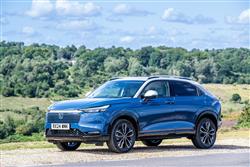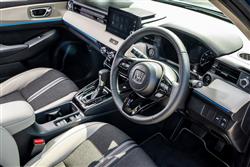Honda HR-V e:HEV - ABC Leasing
FULL OF EASTERN PROMISE?(some text hidden)
By Jonathan Crouch
Ten Second Review word count: 73
This 'RV'-era MK3 Honda HR-V is part of an e:HEV generation of efficient Honda SUVs and here has been subtly updated. As before, it uses a self charging full-Hybrid with a fiendishly clever powertrain. And there's a sophisticated interior that retains the brand's trademark 'Magic' folding seats. In short, there's lots to like here. A large number of HR-V owners buy another and this updated third generation model aims to keep them loyal.
Background word count: 205
Here, Honda's third generation HR-V small e:Hybrid SUV gets a mid-term wash 'n brush-up, yet still retains its practical virtues. Here, we're going to take a closer look. You could argue - and Honda does - that the HR-V was the originator of today's over-populated segment for compact SUVs. It certainly wasn't a generally recognised genre when the first generation GH-series model was launched back in 1999, marketed by the brand as 'the joy machine'. But production petered out in 2005 and amazingly, there was no replacement until the second generation RU-series model came along in 2013, by which time Honda had missed the boat for volume sales in this segment. Second prize was to claw back some profit by positioning the HR-V as a slightly 'premium' choice in its sector, which was the task assigned to this third generation RV-series design which first arrived back in 2021. Its major headline was an exclusive focus on Honda's e:HEV full-Hybrid technology which the brand hoped would justify a slight move up-market in terms of both size - and price. Sales veered on the steady side of slow prior to the arrival of this lightly facelifted model in Autumn 2024. Should it factor in your class deliberations?
Driving Experience word count: 233
This MK3 HR-V shares both its 'Global Small Car' platform and its 1.5-litre four-cylinder Hybrid petrol engine with the current Jazz supermini. As there, a pair of electric motors, based alongside the engine, are at lower speeds responsible for most of the propulsion, the petrol powerplant serving mostly as a generator. Only at high speeds does the engine take over, with an output of 131PS - slightly more than the Jazz because of the HR-V's larger size. The powertrain works in either of three selectable drive modes - 'Eco', 'Normal' and 'Sport' - all of which offer different levels of electric-combustion input. The powertrain itself automatically switches between three settings as you drive - 'Electric Drive', 'Hybrid Drive' and 'Engine Drive' - to maximise efficiency. When driving at a constant high-speed, such as on the highway, the system operates in 'Engine Drive' form, as that is most efficient for cruising. If further acceleration is required, such as when overtaking, the car will switch to 'Hybrid Drive' to gain the necessary extra performance boost. Despite a bigger battery pack than that used on the Jazz - 60 cells rather than 48 - the car can't drive very far in all-electric form. Instead, it's all about how efficiently the electric power can be provided - and then deployed for as much city driving as possible. There's 253Nm of torque and 62mph from rest takes 10.6s.
Pictures (High res disabled)

.jpg)
.jpg)
.jpg)
.jpg)
.jpg)
.jpg)
.jpg)
.jpg)
.jpg)
.jpg)
.jpg)

Scoring
Category: Compact Car
| Performance | |
| Handling | |
| Comfort | |
| Space | |
| Styling | |
| Build | |
| Value | |
| Equipment | |
| Economy | 70% |
| Depreciation | 70% |
| Insurance | 70% |
| Total | 68% |